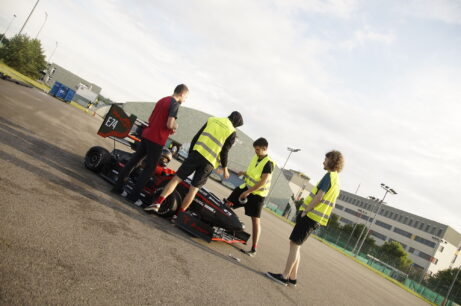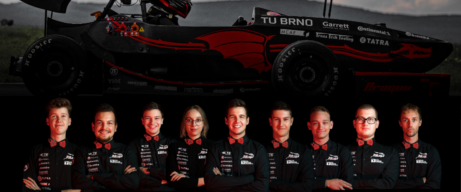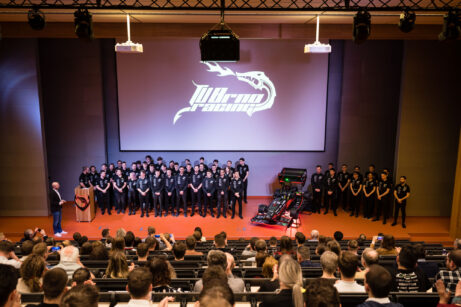What’s new in Dragon X
In our last article, you could learn that we decided to make a difficult plan for this year’s season, namely to build two racing cars, combustion and electric.
Therefore, we have decided to bring you a more experienced Dragon this time, Dragon X, which is powered by an internal combustion engine.
As a team in this category, we are at the top of the world rankings (9th World, 3rd Europe), which means that for this year we had a difficult task in meeting expectations and at the same time bringing innovation to the established concept.
The biggest change is the one in the chassis concept, where the monocoque as a coherent whole was used for the first time in our team, which is a big change compared to the Dragon 9, where the concept consisted of a monocoque and a tubular steel frame at the rear of the monopost. The main advantages of this solution are weight savings and increased torsional rigidity. The difference in weight of the Dragon X compared to last year’s model is 20 kg.
Of course, this change had a significant impact on all the other sections that had to adapt to the innovations in order for the car to function as a whole.
However, this did not deter us from improving the other parts of the monopost either. Big changes to the chassis are, for example, rear wheels steering or MR shock absorbers, which increase the overall time performance of the car per lap. The car has a double trapezoidal suspension with Roll-Heave suspension. In total, the monopost has two shock absorbers for each axle, which are common to both wheels on a given axle, and this concept makes it possible to control driving conditions such as cornering or driving on a straight line independently of each other.
Changes were made not only in the mechanical parts of the monopost, but also in the electrical section. A 3D printed electronically controlled throttle valve of our own design has been added to save weight. However, the valve is not the only innovation, a significant step forward is also the concept of cooling fans, which connects several sections of our monopost. The advantage of the new BLDC fans compared to last year’s concept is the ability to regulate their performance as needed.
The development also took place on the aerodynamics of the monopost, where this year’s model also uses a physical phenomenon known as the “Ground Effect”, which is achieved by the flow of air under the monopost. Thanks to the Ground Effect, the car is stuck to the ground, thus improving its driving abilities. At the same time, our monopost drives this accelerated and directed air through the water cooler of the water circuit of the drive unit cooling. Thanks to the above-mentioned BLDC fans, more air is sucked from under the floor, which results in an intensification of the phenomenon described above, and we come to the “Power Ground Effect” concept.
The power unit that was installed in our Dragon is a characteristic feature of our team in the last decade. It is a supercharged single cylinder built on the basis of the Husqvarna FE501. Supercharging is provided by a turbocharger from Garret Motion, which, thanks to this concept, brings us to the level of competition performance with non-supercharged 4-cylinders, but with significant weight savings, which make our powertrain a very sophisticated power unit. This concept has been used since Dragon 5, so pushing the limits is getting harder and harder, but that didn’t deter us, and not only the propulsion but also the drivetrain went through interesting changes. As mentioned above, the change in concept also affected the powertrain section, when e.g. the compressed air intercooler has changed its position compared to the Dragon 9 and is currently located above the head of our engine.
On the sides of the monocoque in the side pods, there is both an oil cooler and a carbon muffler, the development and production of which we cover ourselves.
The parts in this section are also relieved for this season, when we decided to design and manufacture our own compressed air gearshift cylinder, or a modified differential cage, which weighs 300g less than last year due to a change in the chassis concept.
An innovation in the monopost drivetrain system is, for example, the adjustment of the differential ramps, when we as a team came up with a proposal for a change that should improve the control of the monopost for our pilots and we believe that this change will be reflected in lap time.
This year we also focused on the development of the software side of the power unit, and after several years we decided to embark on a significant project, such as the break release and mapping of our power unit on a dynamometer. The main purpose is to calibrate the fuel map and change the duty between the individual injectors in order to increase performance.
Also interesting can be the 3D printed exhaust plenum made of stainless steel of our design, or already started projects such as an electronic compressor, which could replace a conventional turbocharger in the coming years. We are also working on the development of our own engine cranks, which will enable the incorporation of a differential.
All of the above changes will take time to fine-tune during testing, but ultimately we believe in a functional, reliable and competitive monopost for this season. Keep your fingers crossed for us.
Patrik Matoušek



